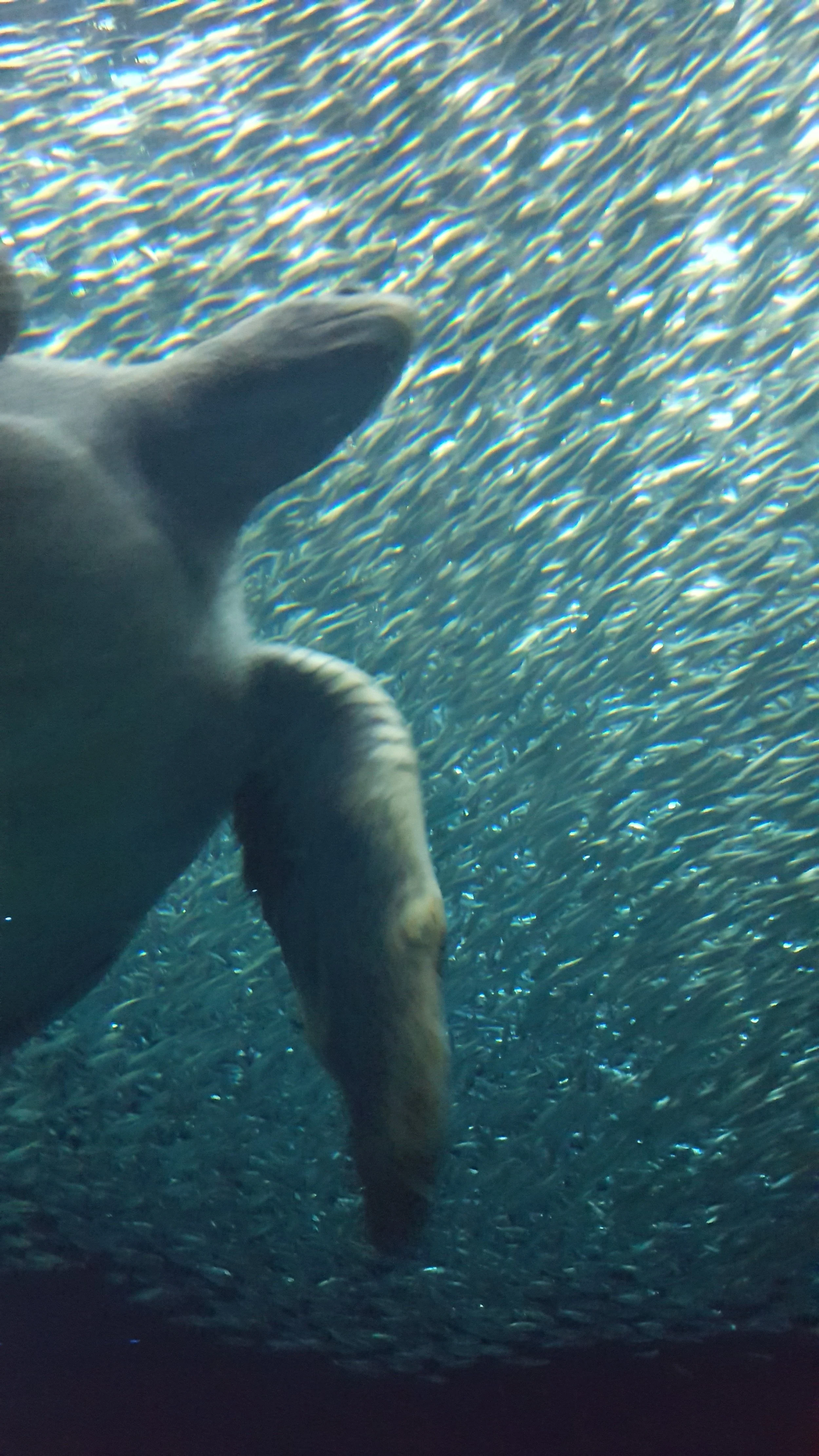How Do Eels Generate Electricity & Other Fun Facts
The woman stood in the dark cover of the room. A green animal draped itself over her shoulders, winding from her chest up over her shoulder and down her back. Dum, dum, dum!
Okay, so the animal was a stuffed toy and the woman was standing in a dark corner because that’s where the real creature (an electric eel) swam in its tank.
I was downstairs inside the California Academy of Sciences museum during one of their Thursday Nightlife events. I’d come on a date but had become fully engrossed in things like new coral growth in Honduras and, in that moment, with electric eels.
I guess it’s something my kook brain does, jumping to the ‘how’ of it all and getting so caught up that I can’t think of anything else. Take, for instance, my fascination with how trees get water from their roots all the way up to their leaves . Or, as I pointed out to my date (jumping up and down when I found the museum signage that shared the same information I’d deep-dived on last year) that bears only eating a portion of the salmon they catch is not wasteful but actually beneficial for the environment.
We’d strode over to where the woman stood with her toy eel in the dark corner of the downstairs aquarium, and she shared a quick fact about the eel generating electricity through its cells.
“How?” I asked.
It struck me that I had likely been intrigued by this concept as a child watching. I had loved The Little Mermaid, and Flotsam and Jetsam had been two of the scariest characters I’d ever come in contact with at that point.
Fun fact: Flotsam and Jetsam are actually terms for marine debris.
However, my dreams of being a mermaid and getting too distracted by the love story with Prince Eric (as well as my personal fear of King Triton’s wrath) quickly washed that curiosity away.
Now, thirty-five years later I discover that it’s nearly impossible for me to stop thinking about how it all worked.
“It’s like a battery.” The woman said.
No help to me because I did not know how a battery worked.
“We create electricity too. Theirs is just likely more concentrated.” (Either my date or one of my friends said this when I continued to bring up my questions).
This was also no help since I had no idea how we (or any other animal) created electricity either.
“You can watch a whole video about it on YouTube,” the woman finally told me when I’d asked once more about how the nervous system caused electricity to occur in the cells.
So, this weekend, I decided to watch some YouTube videos and read some articles (all linked below). Here’s what I currently understand.
First, what is an electric eel?
Almost every article pointed out that an electric eel is not, in fact, an eel. Rather, they’re a type of knifefish or Gymnotiformes.
It turns out that these fish also have electric organs, only they’re weaker than the strong electric organ that exists in the electric eel.
Second, what is electricity?
Electricity (according to YouTube) is just the movement of electrons. Or the movement of
An electron is a subatomic particle with a negative charge.
The flow of electrons is called the electric current.
Why does an electric charge cause a shock?
My family has a house in the California desert. It can get hot out there. Really hot. 115ºF and sometimes hotter. However, it never felt quite as terrible as a really hot day back home in Hawaii because there’s almost no humidity.
It is dry dry dry.
Though I always loved this dry heat, I did not love the amount of times I’d get shocked opening car doors or touching the metal railing of our coffee table.
As a kid, I’d run across the cream-colored carpet of the sitting room, past its Adobe-style fireplace. Then I’d grasp hold of the metal door handle to the outside patio, and OUCH! I’d get shocked.
It turns out, the friction caused by my running feet released electrons from the carpet which hopped up onto my body. Without the moisture in the air to release some of them into, they waited until I touched metal (a positively charged material) to hop off quickly resulting in the shock.
That’s the other thing to note about charged particles: they are really big on the whole opposites attract thing. Negatively charged electrons will always seek positives.
What does this have to do with an eel’s biology?
Electric eels have special electric cells in their strong electric organ. They also have a unique nervous system that allows them to activate these cells on command.
The electric cells are called electrocytes (not to be confused with electrolytes which threw me off for a long time).
These disk shaped cells usually have a slightly negative charge with positive ions on the outside.
When the eel is ready to use its electricity, its nervous system sets releases acetylcholine, a neurotransmitter.
From what I could gather, the complexities of how this part is done may be take up its own blog post entirely. For now, what it’s important is that this entry of ions into the cell makes one side positive while the other is negative.
As we know, negative loves positive, so electrons want to flow toward the positive side, resulting in the movement of electrons aka an electric current.
Here’s where the exact biology of these eels makes it all the more fascinating!
There isn’t just one electrocyte cell. There are thousands, packed one on top of the other.
This flow ultimately results in the shock of one cell against the next. The negative electrons wanting to hop to the closest positive charged side of a cell. This happens across all the electrocyte cells in just two milliseconds which results in a voltage.
Want another fun fact?
After forgetting for the fourth time what I’d read about how electric currents start to flow, I opened Google to try to relocate one of the articles that I’d read. Instead, I found myself reading a new publication which stated that not only could electric eels create these volts but
They could also stun prey from a distance (the article compares it to using a remote control)
They used the shapes of their bodies to create a more controlled shock so that they immobilize their prey to reposition them for optimal consumption (I guess shrimp are easier to eat head-first)
I never thought date night at the museum would lead to an entire deep dive on electric eels, but I’d call that a success! It also might just be how my brain works. After all, I did geek out about the fact that turtles cry (a LOT), and it’s actually good for them.
Until my next obsession hits, I’ll leave you with the below resources for deep dives of your own.
SCIENTIFIC AMERICAN
A Division of Springer Nature America, Inc.
Date: Dec 5, 2005 https://www.scientificamerican.com/article/how-do-electric-eels-gene/
Copyright 2005 Scientific American, Inc. All rights reserved
Carlson, Bruce
Animal Behavior: Electric Eels Amp Up for an Easy Meal
Current Biology Volume 25, Issue 22, 2015
https://www.cell.com/current-biology/fulltext/S0960-9822%2815%2901162-8
J. Xu and D.A. LaVan. Designing artificial cells to harness the biological ion concentration gradient. Nature Nanotechnology, published online: September 21, 2008. https://www.nist.gov/news-events/news/2008/10/models-eel-cells-suggest-electrifying-possibilities#:~:text=Electric%20eels%20channel%20the%20output,is%20similar%20to%20nerve%20cells.
https://learn.sparkfun.com/tutorials/what-is-electricity/flowing-charges#:~:text=Electrons%20in%20atoms%20can%20act,move%2C%20we%20can%20create%20electricity.
Eel electricity YouTube video - https://www.youtube.com/watch?v=z0M7_HPSi14
Battery kids’ tutorial YouTube video https://www.youtube.com/watch?v=VaT2s7FvTF0










